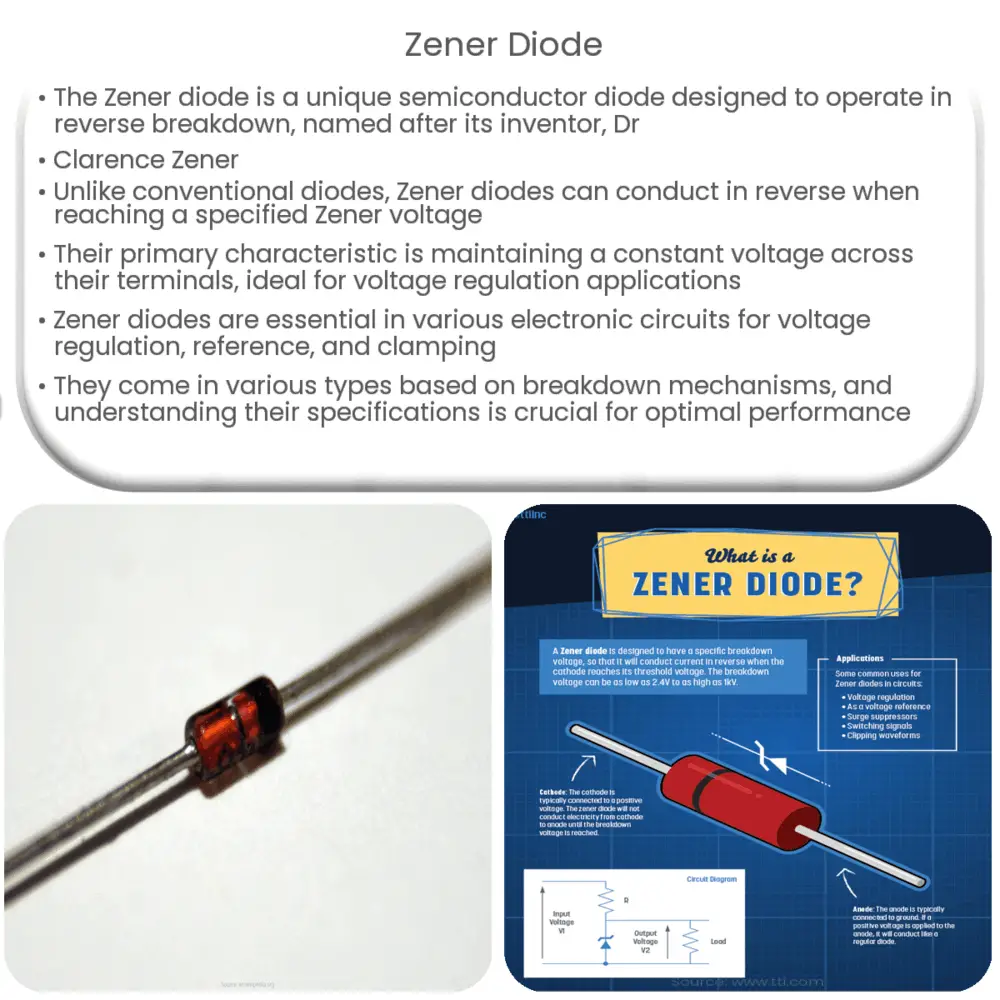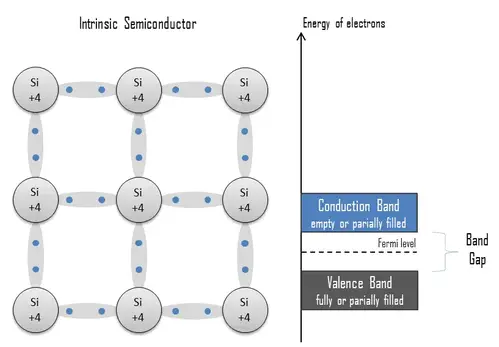A Zener diode is a semiconductor device that regulates voltage by conducting in reverse bias, ideal for voltage stabilization and clamping applications.

Zener Diode: An Introduction and Its Applications
Introduction
A Zener diode is a special type of semiconductor diode that is designed to operate in the reverse breakdown region. It is named after its inventor, Dr. Clarence Zener, an American physicist who discovered the phenomenon of Zener breakdown in the early 20th century. Unlike conventional diodes, which allow current to flow in only one direction (from anode to cathode), Zener diodes can also conduct current in the reverse direction when a specific reverse voltage, known as the Zener voltage, is applied across its terminals.
Zener Breakdown
The primary characteristic that sets Zener diodes apart from regular diodes is their ability to break down in reverse bias. This breakdown occurs when the electric field across the semiconductor becomes strong enough to generate electron-hole pairs, leading to an avalanche effect. The Zener breakdown voltage is the voltage at which this process takes place, and it is a well-defined and stable value for each Zener diode. This unique feature allows Zener diodes to maintain a constant voltage across their terminals, making them ideal for voltage regulation applications.
Construction and Symbol
Zener diodes are typically constructed using silicon or gallium arsenide, which are doped with impurities to create a highly resistive region called the depletion layer. The doping process increases the number of free charge carriers, which helps maintain a stable reverse breakdown voltage. The physical structure of a Zener diode is similar to that of a regular diode, with a PN junction formed by joining P-type and N-type semiconductor materials.
The symbol for a Zener diode is derived from the standard diode symbol, with the addition of two bent lines (or “Z” lines) on the cathode side, representing the Zener breakdown characteristic. The anode is represented by a vertical line with a triangle pointing towards the cathode, while the cathode is represented by a horizontal line. The Zener diode symbol is easily distinguishable from that of a conventional diode.
Applications of Zener Diodes
Zener diodes are widely used in various electronic circuits and devices due to their voltage regulation and clamping capabilities. Some common applications include:
- Voltage Regulation: The primary function of a Zener diode is to maintain a stable output voltage, regardless of changes in input voltage or load current. This makes it an essential component in voltage regulator circuits, which are used to provide a constant voltage supply to sensitive electronic components.
- Voltage Reference: Zener diodes can serve as voltage references in analog-to-digital converters (ADCs) and digital-to-analog converters (DACs), providing a stable reference voltage for accurate signal conversion.
- Voltage Clamping: In circuits where voltage spikes can cause damage to sensitive components, Zener diodes can be used as voltage clamps to limit the voltage to a safe level.
In the second part of this article, we will discuss the characteristics and specifications of Zener diodes, as well as their different types and practical tips for selecting and using them in electronic circuits.
Characteristics and Specifications of Zener Diodes
When selecting a Zener diode for a specific application, it is essential to understand its characteristics and specifications. Some of the key parameters to consider include:
- Zener Voltage (Vz): This is the reverse breakdown voltage at which the Zener diode starts to conduct current in the reverse direction. It is a critical parameter, as it defines the voltage at which the diode will maintain a stable output. Zener voltages can range from a few volts to several hundred volts, depending on the diode’s design and doping levels.
- Power Dissipation (Pz): The power dissipation rating specifies the maximum amount of power that the Zener diode can safely dissipate without causing damage. It is essential to choose a diode with a power rating suitable for the application, as exceeding this limit can cause the diode to overheat and fail.
- Reverse Current (Iz): The reverse current is the current that flows through the Zener diode when it is operating in the reverse breakdown region. It is important to consider the maximum allowable reverse current for a given application to ensure that the diode can handle the required load without exceeding its power dissipation limit.
- Temperature Coefficient (TC): The temperature coefficient indicates how the Zener voltage changes with temperature. Some Zener diodes have a positive temperature coefficient (voltage increases with temperature), while others have a negative temperature coefficient (voltage decreases with temperature). Choosing a diode with a low temperature coefficient can help ensure stable voltage regulation over a wide temperature range.
Types of Zener Diodes
Based on their breakdown mechanism and voltage range, Zener diodes can be broadly classified into two types:
- Avalanche Diodes: These diodes have a higher breakdown voltage (above 5V) and rely on the avalanche effect for reverse breakdown. They exhibit a positive temperature coefficient and are commonly used in high-voltage applications.
- Zener Diodes: With a breakdown voltage below 5V, these diodes operate through the Zener effect and have a negative temperature coefficient. They are primarily used in low-voltage applications.
Practical Tips for Using Zener Diodes
When implementing Zener diodes in electronic circuits, consider the following practical tips for optimal performance:
- Use a series resistor with the Zener diode to limit the current flow and prevent damage due to excessive power dissipation.
- Choose a Zener diode with a power rating higher than the maximum power expected in the application to ensure reliable operation and prevent premature failure.
- For temperature-sensitive applications, select a Zener diode with a low temperature coefficient to maintain stable voltage regulation across varying temperatures.
- Consider the physical size and package type of the Zener diode, as this can impact thermal performance and heat dissipation capabilities.
In conclusion, Zener diodes are versatile electronic components with a wide range of applications in voltage regulation, voltage referencing, and voltage clamping. Understanding their characteristics, specifications, and types can help you select the appropriate Zener diode for your specific application and ensure reliable performance in your electronic circuits.



